标签:des style blog http color os strong io
Techniques are presented that include determining, for data to be written to a nonvolatile memory, a location in the nonvolatile memory to which the data should be written based at least on one or more wear metrics corresponding to the location. The one or more wear metrics are based on measurements of the location. The measurements estimate physical wear of the location. The techniques further include writing the data to the determined location in the nonvolatile memory. The techniques may be performed by methods, apparatus (e.g., a memory controller), and computer program products.
This invention relates generally to non-volatile memory and, more specifically, relates to wear leveling in this memory.
Wear leveling is fundamental part of every controller for nonvolatile memories, including Flash memory and other memories such as phase change memory. The role of wear leveling is to extend the life of a memory system by preventing a small fraction of the memory from being worn out prematurely due to non-uniform access patterns over the address space of the memory. That is, if one fraction of the memory is accessed much more than other fractions, the fraction with the higher access will generally wear out faster than the other fractions.
In conventional systems, an attempt is made to make uniform the number of writes performed on different memory blocks in the memory. While this type of wear leveling has advantages, it could be improved.
Techniques are presented that include determining, for data to be written to a nonvolatile memory, a location in the nonvolatile memory to which the data should be written based at least on one or more wear metrics corresponding to the location. The one or more wear metrics are based on measurements of the location, the measurements estimating physical wear of the location. The techniques further include writing the data to the determined location in the nonvolatile memory. The techniques may be performed by methods, apparatus (e.g., a memory controller), and computer program products.
As stated above, wear leveling is fundamental part of every controller for nonvolatile memories, including Flash memory. All nonvolatile memory has a limited lifetime. Flash cells, as a particular example, have very limited endurance. The aim of wear-leveling is to wear out Flash cells at a roughly uniform rate, by roughly equalizing the number of writes across all Flash blocks. This can be performed, for instance, by storing write-counts as metadata per block. Shown in?FIG. 1?is an example physical address map?100?with this type of metadata. In this example, write count metadata is stored as a number of writes?120?for each physical page address (PPA)?110, each of which is mapped to a corresponding one of N logical address?130. This metadata is used to perform the following:
Select an erased block (e.g., by selecting a corresponding PPA?110) which will become the next active block to be written, based on the write counts in number of writes?120; and
Select the occupied block (e.g., by selecting a corresponding PPA?110) to be erased based on the write counts (number of writes?120) of occupied blocks. The selected "erased" block is written with the data and the selected occupied block is erased. Note that the map?100?may also include whether blocks are erased or occupied, as additional metadata.
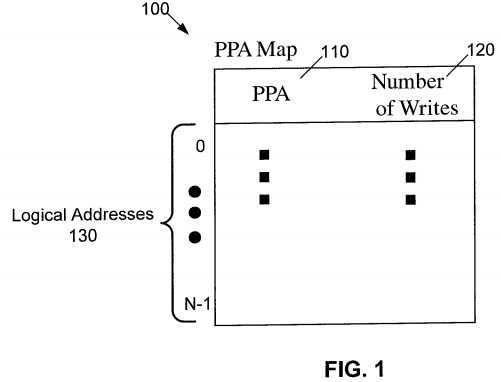
While this type of wear leveling is useful, due to heterogeneities in the memory device, different blocks/cells may not wear at the same rate. Thus, conventional methods may not be optimally effective for maximizing the lifetime of the memory device. The following paper describes and discusses this phenomenon for the case of NAND Flash but does not describe methods for making wear uniform: "Exploiting Memory Device Wear-Out Dynamics to Improve NAND Flash Memory System Performance", Yangyang Pan, Guiqiang Dong, and Tong Zhang, Rensselaer Polytechnic Institute, USA. FAST 2011.
Exemplary embodiments of the instant invention describe systems, program products, and methods for wear-leveling in memory devices, which take into account the variability in wear due to heterogeneity. Exemplary techniques ensure that the wear is made uniform or more uniform across the device, rather than making the number of writes uniform or more uniform across the devices. Techniques are described for NAND Flash memories, as well as other memory devices such as phase change memories/storage class memories.
For ease of understanding and exposition, the description herein is divided into nonvolatile memories that use write-in-place and nonvolatile memories that do not use write-in place (also termed overwrites). By way of introduction, write-in-place is an approach where a data block may be written to the same physical location in memory, without any specific preparation. That is, if a system requests data to be written at a logical address of X, a memory controller may write the data to a corresponding physical address of Y. In terms of conventional wear leveling, the memory controller may write the data at a different physical address (e.g., Z). Regardless, there is some correspondence between logical addresses and physical addresses when data is to be written over data already existing in the memory. NAND Flash is an example of a memory which does not use write-in-place because the memory requires erasing a block of pages before writing a page in the block. Flash typically writes the data to an entire "page" (e.g., a group of cells) at a single time. The pages are grouped into blocks, and the pages typically have to be written one at a time. Furthermore, there is a pool of active pages, and these pages are the pages used for any new writes. Any writes to data already existing on the memory may be performed by writing the data to a new location in memory and marking as invalid the data at the old location.
Regarding variability aware wear leveling for nonvolatile memory using write-in-place, such memory includes phase-change memory (PCM) and storage class memory (SCM) but is not limited to these memories.
Turning to?FIG. 2, a block diagram of an exemplary nonvolatile memory?200?is shown in accordance with an exemplary embodiment of the instant invention. Nonvolatile memory?200?includes a memory controller?220?that accesses (e.g., reads from and writes to) memory device?240. The memory controller?220?also accesses (e.g., reads from and writes to) metadata storage?210, which includes wear information. Further, the memory controller?220?also accesses (e.g., reads from and writes to) the indirection table?285, which contains a mapping from logical addresses (LAs)?130?to physical page addresses (PPAs?110). The memory device?240?includes a number of pages?245-1?through?245-N of memory. The memory controller?220?includes a write page selector?225?and other controller functions?235. The memory controller?220?implements probabilistic swap-based page selection, e.g., using write page selector?225. Some part or all of the memory controller?220?may be implemented via firmware230, which is a computer readable storage medium having computer readable program code embodied therewith. Firmware?230?may be updated to modify functionality, and the memory controller?220?may therefore be or include circuitry (e.g., a processor) configured to execute the computer readable program in the firmware?230. Alternatively or in addition, some or all of the functionality of memory controller?220?may be implemented strictly in hardware, such as by circuitry in an integrated circuit.
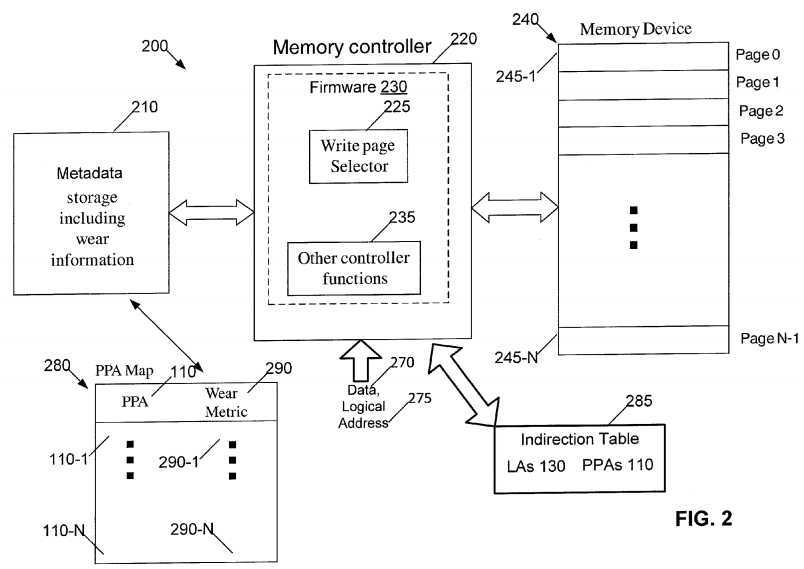
One example of metadata storage?210?is shown as a PPA map?280, which is similar to the PPA map?100?shown in?FIG. 1. However, the PPA map?280includes a wear metric?290. Metadata tracking the physical wear of each physical page is included as the wear metric?290. The wear metric?290?is an entity that corresponds to a measurement of the state of the memory and that estimates a physical wear of the location, hence a number of writes is not a wear metric. Each of the PPAs corresponds to one (e.g., or more) of the pages245. It is noted that the indirection table?285?and the PPA map?280?may be combined if desired.
In an embodiment, the memory device?240?is a PCM memory device comprising a large number of pages?245. For ease of reference, the locations in memory being accessed herein are referred to as pages (e.g., pages?245). It is noted, however, that pages?245?(and pages described below) may be a set of memory cells written at the same time, as part of a single write operation. Additional examples include a memory word, a cache-line, or some other unit. In conventional systems, wear-leveling is performed by swapping the page being written with another page selected uniformly at random from all the pages?245?in a memory and this swap operation is performed with a probability which is constant and independent of the wear of either page.
By contrast, in an exemplary embodiment, the wear-leveling is variability-aware. That is, the swap probability is a function of estimates of the physical wear of both pages (e.g., the page originally to be written to and a selected page). The wear can be estimated using wear metrics?290?which include, but are not limited to, the observed bit-error rate (BER), as well as physical characteristics such as number of stuck bits in the page and write/read latency, number of defects, read and write power, or storage capacity, all of which may be correlated with the physical wear out of a line (e.g., or other unit of) memory. Thus, the wear metrics are based on measurements of a memory location, and the measurements estimate physical wear of the location. As an example, the line which has a higher BER than average would have a higher probability of being swapped out, and this line would only be swapped out with a line which has lower a BER than average.
As another example, when a page is to be written to with received data?270?(e.g., because a received logical address?275associated with the data maps to a PPA?110), with some probability, a decision is made (e.g., by write page selector?225) to swap the data of the page with another selected page. The probability of swap is dependent on the page wear (e.g., as quantified by the wear metric?290): the higher the wear, the greater the probability that a swap is performed. In one embodiment, one or more swap candidate pages?245?are selected at random, and the candidate page?245?with the least wear is selected as the page?245?to which the data will be written. In an example embodiment the swap probability increases exponentially with the difference between the page wear and the average wear.
As an example, assume data?270?is requested to be written to a logical address?130, which corresponds to a received logical address?275. If the logical address?130/275?maps via the indirection table?285?to a PPA?110-1?(corresponding to an "original" page?245-1), the probability of swap is based on the corresponding wear metric?290-1. If the memory controller200?(e.g., the write page selector?225) determines the page?245-1?should be swapped, the memory controller?200?(e.g., the write page selector?225) selects a different PPA?110?and corresponding page?245. Assume the different PPA?110corresponds to selected page?245-30. The memory controller?200?(e.g., the write page selector?225) then writes the data275?to the selected page?245-30?instead of to the original page?245-1.
It is noted that if the selected page?245-30?had valid data, the memory controller?220?would read the selected page?245-30and write the read data to the original page?245-1. Thus, if the memory controller?220?swaps pages X and Y and both have valid data, then both pages X and Y will be written to once. The notion, though, is that address patterns of most workloads show temporal correlations, i.e., if a particular logical address is being written to now, it is likely that this address will be written to frequently in the future as well. Thus once the swap is performed, the future writes to that address will go to X instead of Y. These future writes will cause wear on X and not Y, thereby leading to leveling.
The indirection table?285?tracks the mapping of logical addresses?130?to physical pages (via corresponding PPAs?110).
Turning now to?FIG. 3, a block diagram is shown of a flowchart to provide variability aware wear leveling in an exemplary embodiment.?FIG. 3?is a logic flow diagram performed by hardware (e.g., by the controller?220?executing firmware?230?or by logic elements in controller?220?configured to perform the blocks), performed by a method, or is a result of execution of computer program instructions embodied on a computer readable storage medium such as firmware?230. For ease of reference, it is assumed herein that the blocks in?FIG. 3?are performed by a memory controller such as memory controller220.

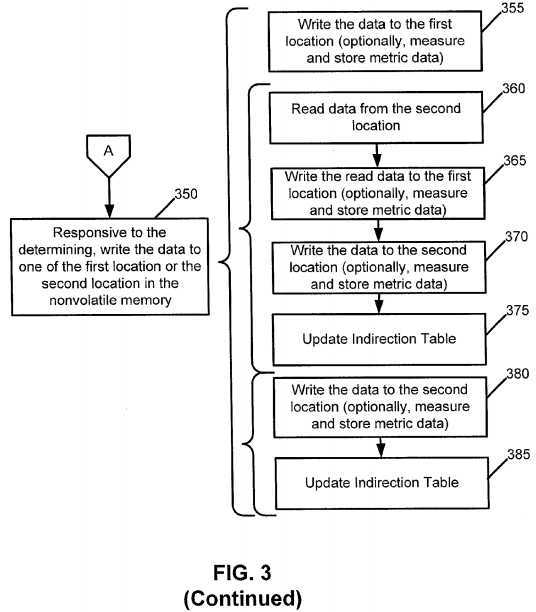
In block?305, the memory controller?220?measures and stores wear metric data. The measurement may occur in relation to the process of reading from or writing to the locations in memory (e.g., temporally related to reading from or writing to the locations in memory), may be performed as a process separate from reading from or writing to the locations in memory (e.g., as a background process), may be some combination of these, or may be any other technique for measuring wear of a non-volatile memory. Such processes could, for example, access a memory location, read and decode the stored data and measure the bit error rate; the processes could also for example read the data, buffer the data, test the memory location for stuck cells and then write back the data, putting the stuck cell information in a table. As indicated above, such wear metric data can include one or more of BER, number of stuck bits in the page, write/read latency, number of defects, read and write power, and/or storage capacity. Block?310?illustrates that the memory controller?220?may determine values of metrics of wear metric data. That is, the memory controller?220?may determine (and store) values for average wear, median wear, highest wear and lowest wear.
Note that block?305?(and?310, if performed) may have to be performed for a while before enough wear appears to generate relevant wear data. That is, before block?315?is performed, there may be a number of cycles that could be performed, although this depends on the memory technology. In Flash memory, block?315?could be performed from beginning of life. In other memory types, block?315?could be performed, e.g., at 50-60 percent life.
In a broad sense, the memory controller?220?can, for data?270?to be written to the nonvolatile memory, determine a location in the memory the data?270?should be written based at least on a wear metric?290?corresponding to the location in the nonvolatile memory (e.g., memory device?240). More specifically in an example, in block?315, for data?270?to be written to a first location (e.g., a page?245) in nonvolatile memory (e.g., as indicated by a PPA?110?in indirection table?285corresponding to the logical address?275), the memory controller?220?can determine whether the data?270?should be written to the first location or written to a second location (e.g., another page?245) in the nonvolatile memory. The determining is based at least on wear metrics?290?corresponding at least to the first and second locations.
In one example, block?315?may be performed by the memory controller?220?wherein the determining is based on swap probability, which is a function of wear (corresponding to wear metrics?290) of first and second locations. See block?320. In general, as described above, higher swap probability should occur for pages with higher wear, and the pages with higher wear should be swapped with pages of lower wear. Block?320?may be performed in an example by blocks?330?and?340. In block?330, the memory controller?220?calculates probability of swap for the first location based on wear (e.g., if wear increases, probability of swap increases). In an embodiment the probability of swap increases exponentially with wear. Functions other than the exponential function can be used as well. In block?340, if the calculated probability indicates a swap should be performed (e.g., the probability meets a threshold, such as being above the threshold), then the memory controller?220?can select one or more candidate locations (either randomly or selected to have less wear than wear of the first location), and select candidate location (e.g., responsive to the amount of wear and physical placement of the location) as the second location. As described below, block?340?may also be one way to perform block?315.
Note that the values of wear metric data from block?310?may be used in blocks?315?to?340. For instance, the probability for the first location may be determined (block?320) based on difference between wear of the first location and the average wear of all locations, e.g., the probability of swap increases as the difference increases between wear of the first location and the average wear of all locations. As another example, the selection of candidate locations (block?330) may be based on the average wear, such that a location is more likely to become a candidate the lower the location‘s wear is relative to an average wear. Alternatively, the candidates may be selected as a group of locations having the lowest wear as compared to other locations. As another example, the locations within a certain amount of wear from the location having the lowest wear can be candidate locations. As another example of block?315, if the first location is within a certain amount of wear from the location having the highest wear, the block is automatically swapped, and block?340?is performed to select the one or more candidate locations.
In block?350, the memory controller?220, responsive to the determining, writes the data to one of the first location or the second location in the nonvolatile memory. There are multiple options for this, as illustrated by block?355, blocks?360-375, and blocks?380-385. In block?355, the memory controller?220?writes the data to the first location. Additionally, metric data may optionally be measured and stored (see blocks?305?and?310). Block?355?occurs if the determining selects the first location.
Blocks?360-375?occur if the determining selects the second location and the second location is known to contain valid data. In block?360, the memory controller reads data from the second location, then writes the read data to the first location (block?365) (e.g., and optionally measures and stores metric data as in blocks?305?and?310). In block?370, the memory controller writes the data?270?to the second location (e.g., and optionally measures and stores metric data as in blocks?305and?310). In block?375, the memory controller?220?updates the indirection table?285?to indicate the swap (i.e., the PPAs110?are changed for the two LAs?130?corresponding to the first and second locations).
Blocks?380-385?may be performed if the determining selects the second location and it is known the second location does not contain valid data. In this case, the first location would be marked as no longer having valid data. The memory controller220?writes the data?275?to the second location (block?380) (e.g., and optionally measures and stores metric data as per blocks?305?and?310). In block?385, the memory controller?220?updates the indirection table?285?to indicate the swap (i.e., the PPAs?110?are changed for the two LAs?130?corresponding to the first and second locations).
Regarding variability-aware wear leveling for nonvolatile memory not using write-in-place, in an embodiment, the memory device is a NAND Flash memory device wherein the minimum erase unit is a block consisting of multiple pages. Before proceeding with additional description of exemplary embodiments herein useful for NAND Flash memory devices, a description is presented of typical NAND Flash memory devices.
Turning to?FIG. 4, a block diagram is shown of an exemplary NAND block?500?forming a portion of a NAND memory device. NAND block?500?includes a row of transistors?520?enabled or disabled using a String Select Line (SSL), a row of transistors540?enabled or disabled using a Ground Select Line (GSL), and m rows of storage cells?530. Each of the rows in this example has 4 k bytes, where "k" is 1024. There are n columns, each of which corresponds to a bitline (BL). Each of the rows of storage cells?530?is a NAND page?510?and is accessed using a corresponding wordline (WL). This example has 64 pages?510.

In NAND Flash, pages are the smallest write units, and blocks (e.g., 64 pages) are the smallest erase units. Once a cell530?is programmed (e.g., changed from 1 to 0), the cell?530?cannot be changed, until the entire block?500?is erased. Block erasing is a very costly operation (the operation takes about 2 ms, milliseconds), so erasing needs to be performed as rarely as possible. Thus, in practice, when a logical address has to be rewritten, the logical address is mapped to a different physical page?510, and the old page is invalidated. This sets up the need for garbage collection to free invalid pages.
Referring to?FIG. 5, a block diagram of a typical NAND Flash setup for a NAND Flash memory device?600?is shown. There are n channels?610?in the NAND Flash memory device?600. Each channel?610?has both free blocks?620?and occupied blocks630. This example shows there are two active blocks?500-1?and?500-2?in each of the free blocks?620. Each block?500?may include erased pages?510?(marked with an "E"), valid programming pages?510?marked with a "V"), or invalid programmed pages?510?(marked with an "Inv"). The "clear" pages (510-1?and three pages in block?500-1?of Channel n) represent erased pages within a non-erased block, i.e., blocks which have some non-erased pages (and some erased pages).
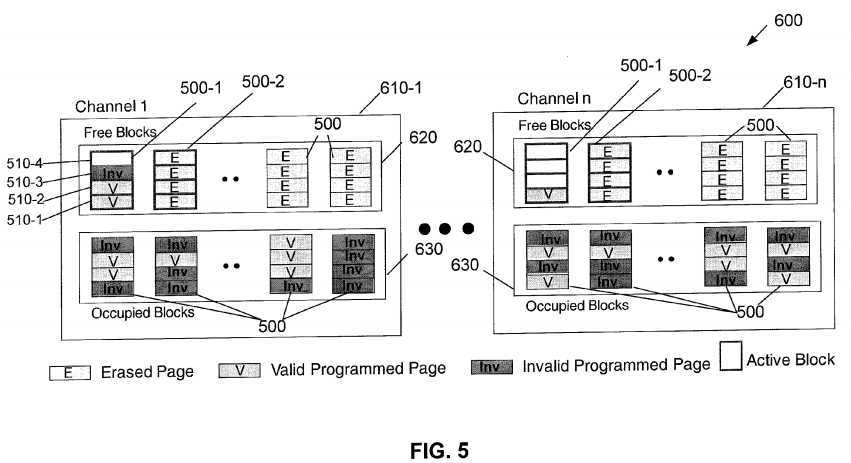
NAND Flash has page-write but block-erase (each block is typically 64-128 pages). A block?500?has to be erased before a page?510?on the block?500?can be re-written. Pages?510?on a block are written sequentially, e.g., from bottom to top inFIG. 5. That is, for block?500-1?in channel?610-1, first page?510-1?would be written, then page?520-2?would be written, then page?520-3?would be written, then finally page?520-4?would be written. A Flash channel?610?includes multiple devices each of which includes multiple blocks. Each Flash device, and hence channel?610, has free blocks?620?and occupied blocks?630. Free blocks?620?have at least one erased page. Flash is typically log-based. Each Flash channel?610?has one or more "active" blocks shown as blocks?500-1?and?500-2?in this example. New page writes on the channel are performed to the active blocks. In particular, the next free page?510?in a selected active block (e.g.,?500-1) is written to in sequence. That is, referring to block?500-1?of free blocks?620, page?530-1?is written to before page?510-2?is written to.
FIG. 6?is a block diagram of an exemplary NAND Flash memory in accordance with an exemplary embodiment of the instant invention. NAND Flash memory?700?includes a memory controller?720?that accesses (e.g., reads from and writes to) NAND Flash memory device?600. Flash controller?720?also accesses (e.g., reads from and writes to) metadata storage?710, which includes wear information. Flash controller?720?also accesses (e.g., reads from and writes to) Flash translation layer785, which, e.g., maps logical addresses?130?to physical page addresses (PPAs)?110. The NAND Flash memory device is shown in?FIG. 5, although for simplicity the channels?610?are not shown in?FIG. 6. The Flash controller?720?includes a write page selector?725, a garbage collection block selector?705, and other controller functions?735. The Flash controller?720implements probabilistic swap-based page selection for writes, e.g., using write page selector?725, and probabilistic swap-based page selection for garbage collection, e.g., using garbage collection block selector?705. Some part or all of the Flash controller?720?may be implemented via firmware?730, which is a computer readable storage medium having computer readable program code embodied therewith. Firmware?730?may be updated to modify functionality, and the Flash controller720?may therefore be or include circuitry (e.g., a processor) configured to execute the computer readable program in the firmware?230. Alternatively or in addition, some or all of the functionality of memory controller?220?may be implemented strictly in hardware, such as by circuitry in an integrated circuit.
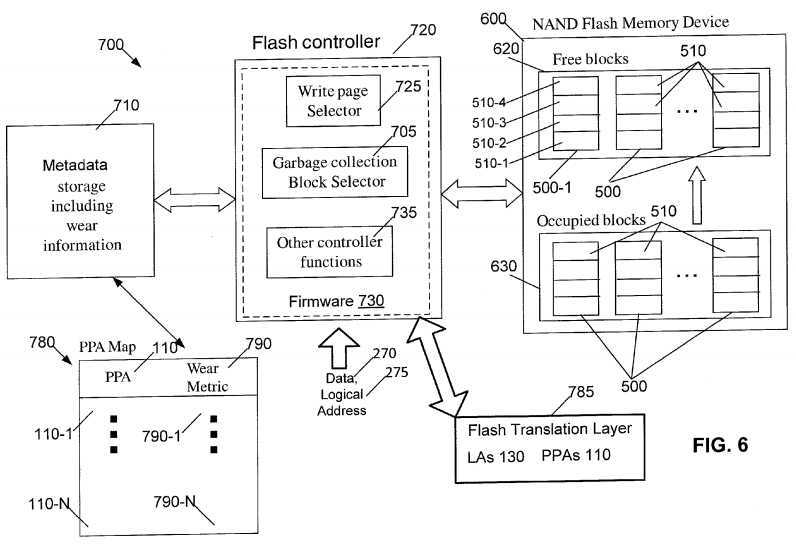
One example of metadata storage?710?is shown as a PPA map?780. The PPA map?780?includes a wear metric?790?and the PPAs?110?correspond to the pages?510. Metadata tracking the wear of each physical page?510?is included as the wear metric?790. Each logical address?130?corresponds to one of the PPAs?110-1?through?110-N and a wear metric?790-1through?790-N.
Some metadata for each page is stored in the indirection table (typically referred to as a Flash Translation Layer, FTL), illustrated in?FIG. 6?as the FTL?785, or in some other part of memory (volatile or nonvolatile) which tracks the health of the page. In the example of?FIG. 6, the PPA map?780?includes the wear metric?790, but the wear metric?790?may be placed in the FTL?785?if desired. In this example, health may be measured, for example, in terms of the recent bit error rate seen on the page and stored as wear metric?790. As stated above, the NAND Flash memory device?600?is used as a log buffer, which has a few active blocks?510?which are currently being written to. Since a Flash block has to be written sequentially, each active block has an active page (such as active page?510-1), i.e., a first page in a sequence which has not yet been written to.
In one embodiment, when a page write is to be performed, a pool of candidate physical pages?510?to write to is collected, which includes the active pages?510?in the active blocks?500?as well as other erased pages?500?(for example, all the pages which sequentially follow the active pages). One of these collected pages is selected by a probabilistic page selection method, where the probability of selecting a particular page is a function of the health of the page as well as the difference in the indices of the page and the current active page in the same block. That is, the probability is based in part on the number of sequential pages skipped. For instance, assume the pages?510-1?through?510-4?in block?500-1?are active (or page?510-1?is active and the blocks?510-2?through?510-4?are erased and available). Assuming the health (as measured by a corresponding wear metric?790) of each page?510-1?through?510-4?is the same. The probability of selecting page?510-1?is the highest; the probability of selecting page?510-2?is lower; the probability of selecting page?510-3?is still lower; and the probability of selecting page?510-4?is the lowest. In an exemplary embodiment, the probability of selecting the page is weighed by a geometrically decaying probability, e.g., 1-p is the probability of selecting?510-1, p(1-p) is the probability of selecting?510-2, p2(1-p) is the probability of selecting?510-3, and so forth, except for the last page available which adsorbs the tail probability of the geometric distribution. In an additional embodiment, the probabilities for?510-1,?510-2, etc., are labeled p1, p2, etc., and are optimized, for example by means of a simulated annealing optimization technique, so as to prevent the write amplification factor to be beyond a pre-specified threshold. In general, skipping active pages increases write amplification by reducing the effective spare area associated with the storage pool.
An exemplary advantage of this method is that the method (e.g., occasionally) skips pages with poor health, and thereby has an equalizing effect on the wear of the Flash memory. This occasional skipping has multiple beneficial effects. The occasional skipping allows the Flash device to wear out uniformly, which improves the life time of the device, and allows low rate scrubbing to be used for much of the lifetime of the memory. Scrubbing is a technique where data is periodically read, verified, and rewritten.
In an alternative embodiment, some active Flash blocks may be non-writable at the time of the request, because the corresponding Flash plane is busy performing some other operation such as an erase. Such blocks are excluded during the candidate page collection process. The Flash plane (also called a Flash die) is independent of the controller?720. The controller?720?typically deals with multiple Flash planes, some of which are busy at a given time, and some of which are non-busy. So, a Flash plane being busy does not imply that the Flash controller is busy. In fact, one of the jobs of the controller?720?is to keep track of busy and non-busy Flash planes, and schedule operations on non-busy Flash planes. The Flash controller?720?is assumed not to be busy or at least not busy in a more significant way than the Flash dies are. If a Flash die is busy doing an operation, all other operations on that die will have to wait.
In another embodiment, the health of the pages?510?is aggregated to form an estimate of block health for each Flash block500. During garbage collection, when a block is to be erased, the factors used to select the block?500?to be erased include the block health. This allows blocks with many low health pages to be erased (and hence written) less frequently, thereby equalizing the wear over the device. Examples of methods used to aggregate page health information include using the mean or median page health for all pages in the block, and using the worst page health in the block.
In another embodiment, a global cumulative distribution of page health over the device?600?is maintained. Whenever an active page?510?has a health which is less than a health of a certain percentage of pages?510?(for example 95 percent), the active page?510?is always skipped during writing.
In another embodiment, static data (i.e., data which is deemed unlikely to be modified in the near future) is written to blocks500?with poor health (e.g., or blocks which have many pages with poor health), and dynamic data (i.e., data which is deemed likely to be modified quickly/frequently) is written to blocks?500?with good health.
Turning to?FIG. 7, a block diagram is shown of a flowchart to provide variability aware wear leveling in an exemplary embodiment.?FIG. 7?is a logic flow diagram performed by hardware (e.g., by the Flash controller?720?executing firmware730?or by logic elements in Flash controller?720?configured to perform the blocks), performed by a method, or is a result of execution of computer program instructions embodied on a computer readable storage medium. For ease of reference, it is assumed herein that the blocks in?FIG. 7?are performed by a memory controller such as Flash controller?720.

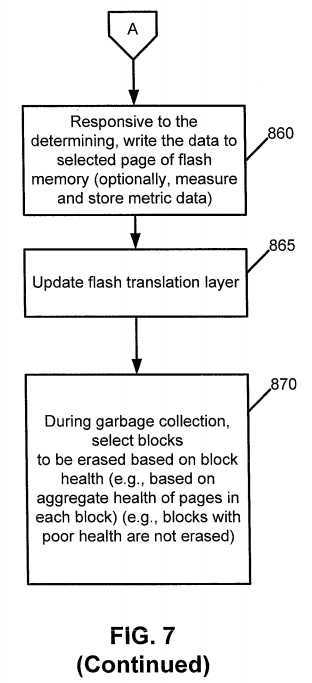
In block?805, the Flash controller?720?measures and stores wear metric data, e.g., on a per-page and per-block basis. The measurement may occur in relation to the process of reading from or writing to the locations in memory (e.g., temporally related to reading from or writing to the locations in memory), may be performed as a process separate from reading from or writing to the locations in memory (e.g., as a background process), may be some combination of these, or may be any other technique for measuring wear of a non-volatile memory. Such processes could, for example, access a memory location, read and decode the stored data and measure the bit error rate; the processes could also for example read the data, buffer the data, test the memory location for stuck cells and then write back the data, putting the stuck cell information in a table. Such wear metrics?790?include one or more of measured BER, number of defects, write or read latency, read and write power, or storage capacity, and the value of the wear metric changes with the amount of usage of the location. Blocks?810-820?are examples of block?805?and include additional wear metrics?790. In block?810, the controller?720determines values of metrics of wear metric?790?data (e.g., average wear, median wear, highest wear and/or lowest wear). Block?810?is typically performed per-page but some or all of this data may be taken per-block (as described in block815). In block?815, the Flash controller?720?aggregates health of pages (e.g., corresponding to wear metrics?790?of the pages?510) to form an estimate of block health for each block?500. As described above, such aggregate can be a mean or a median for pages in a block. In block?820, the Flash controller maintains a global cumulative distribution of page health (e.g., corresponding to wear metrics?790?of the pages?510) over all pages?510?of Flash memory. As described above, block?805?may be performed for some time period prior to performing block?825?and higher numbered blocks, in order for wear metric data to accumulate. Metric and health are used interchangeably herein. Health is somewhat generic and metric is somewhat more precise, as the term metric quantifies a measure of health thus in fact defining precisely an exemplary meaning of health. Health is inversely related to wear, as the higher the wear, the worse the health. The use of the term "health" in?FIG. 7?may therefore be replaced with the term "wear", if desired.
In block?825, the Flash controller?720, for data?270?to be written to the Flash memory, determines a page?510?in the Flash memory (e.g., NAND Flash memory device?600) to which the data?270?should be written based on one or more wear metrics of at least the page?510. Block?825?may be performed by blocks?830-835?or by block?850, as illustrative examples.
In block?830, the Flash controller?720?collects a candidate pool of physical pages?510. As described above, the candidate pool can include e.g., active pages in active blocks as well as erased pages in the blocks with the active pages. In block835, the Flash controller?720?performs a probabilistic page selection. The probabilistic page selection may include where a probability of selecting a particular page?510?is a function of the health (e.g., as determined by the metrics?790) of the page510?as well as a difference in the indices of the page?510?(e.g., page?510-4) and the current active page?510?(e.g.,?510-1) in a same block?500?(e.g.,?500-1), as described above. As a specific example of probability functions, one may divide each page‘s health score by the total sum of the health scores of the pages being considered for the new write. In one exemplary technique for performing block?835, in block?840, the Flash controller?720?excludes blocks?500?not writable at the time the write of the data?270?is to be performed. That is, unavailable blocks?500?do not form part of the candidates. In another example of performing block?835, in block?845, the Flash controller?720?skips any active pages?500?having a health (e.g., corresponding to wear metrics?790) less than a health of a certain percentage of pages?510?based on the global cumulative distribution, e.g., as determined in block?820. This has been described above.
In block?850, another technique for performing block?825?is shown. The Flash controller?720?writes static data to blocks?500with poor health (e.g., blocks?500?which have many pages?510?with poor health). Alternatively, the Flash controller?720writes dynamic data to blocks?500?with good health (e.g., blocks?500?which have many pages?510?with good health, where health is determined using wear metrics?790). That is, data?270?is written to a block with poor health in response to a determination the data is static data or is written to a block with good health in response to a determination the data is dynamic data. For "poor" and "good" health for blocks, a block having poor health means, e.g., a block with a majority of pages having values of a wear metric below an average value of a wear metric and a block having good health may mean a block with a majority of pages having values of a wear metric above an average value of a wear metric. A page with poor health is one whose measured wear metrics are lower than an average and a page with good health is one whose measured wear metrics are higher than an average. These are only examples of good/poor health for blocks and pages. To determine static/dynamic data, one can keep in a table a count of how many times a logical (not physical) address has been written. Logical addresses which are written to less than average can be considered static and logical addresses which are written to more than average can be considered dynamic.
In block?860, the Flash controller?720, responsive to the determining, writes the data?270?to the selected page?510?of Flash memory (e.g., and optionally measures and stores metric data as in blocks?805-820). In block?865, the Flash controller?720updates the Flash translation layer?785?so that the logical addresses?130?and the PPAs?110?correspond correctly.
Another option described above concerns garbage collection. In block?870, the Flash controller?720, during garbage collection, selects blocks?500?to be erased based on block health. That is, blocks having a value of health not meeting (e.g., beneath) some threshold are not collected. This would result in the desired effect of not putting blocks with poor health back in the pool of available blocks for writing. In an example, this is based on aggregate health of pages?510?in each block?500taken in block?815.
As will be appreciated by one skilled in the art, aspects of the present invention may be embodied as a system, method or computer program product. Accordingly, aspects of the present invention may take the form of an entirely hardware embodiment, an entirely software embodiment (including firmware, resident software, micro-code, etc.) or an embodiment combining software and hardware aspects that may all generally be referred to herein as a "circuit," "module" or "system." Furthermore, aspects of the present invention may take the form of a computer program product embodied in one or more computer readable medium(s) having computer readable program code embodied thereon.
SRC=http://www.google.com/patents/US20130339574
Variability aware wear leveling,布布扣,bubuko.com
Variability aware wear leveling
标签:des style blog http color os strong io
原文地址:http://www.cnblogs.com/coryxie/p/3891236.html